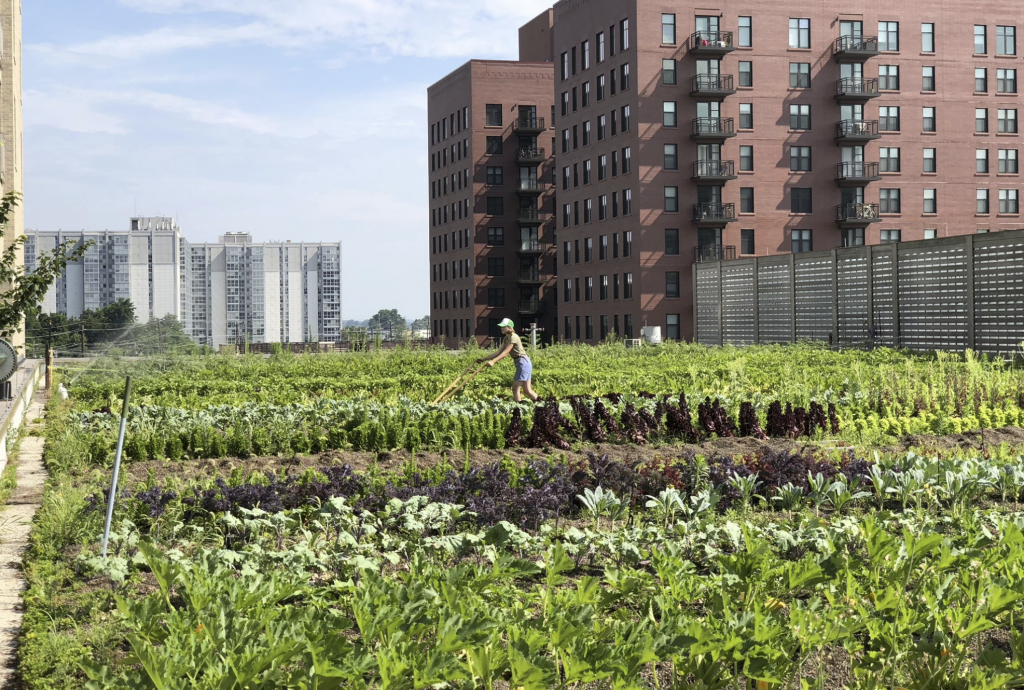
If today’s locavores are enthusiastic about locally grown food because it’s fresher than typical supermarket food and doesn’t need to be preserved and brought in by truck, they’ll be thrilled with the Farm at Pike & Rose. Federal Realty Investment Trust (FRIT) has taken local farming to a new level — to the rooftop access from thesixth floor of one of Pike & Rose’s buildings in North Bethesda, Maryland. Instead of seeing concrete and HVAC equipment on the nearby roof, you see row after row of carefully cultivated crops between furrows of rich soil. Here, on 17,000 square feet of sunny roof, lies the largest rooftop farm in the Mid-Atlantic region.
With its flexible, waterproof membrane, the roof was originally conceived as a green roof to be covered with seeded mats. It was designed to withstand and perform in submersed water conditions like no-slope decks, water features, pools, and vegetated roofs. In 2018, the original plantings were converted to an active urban farm, producing greens and vegetables that are served at restaurant tables 40 feet below and through Community Support Agriculture (CSA) boxes to some residents in the adjacent residences. FRIT brought in an outside expert to manage the new venture, Up Top Acres. The local farming company is committed to converting underutilized spaces into productive farmland and had already been operating farms on a number of DC area rooftops since 2014.
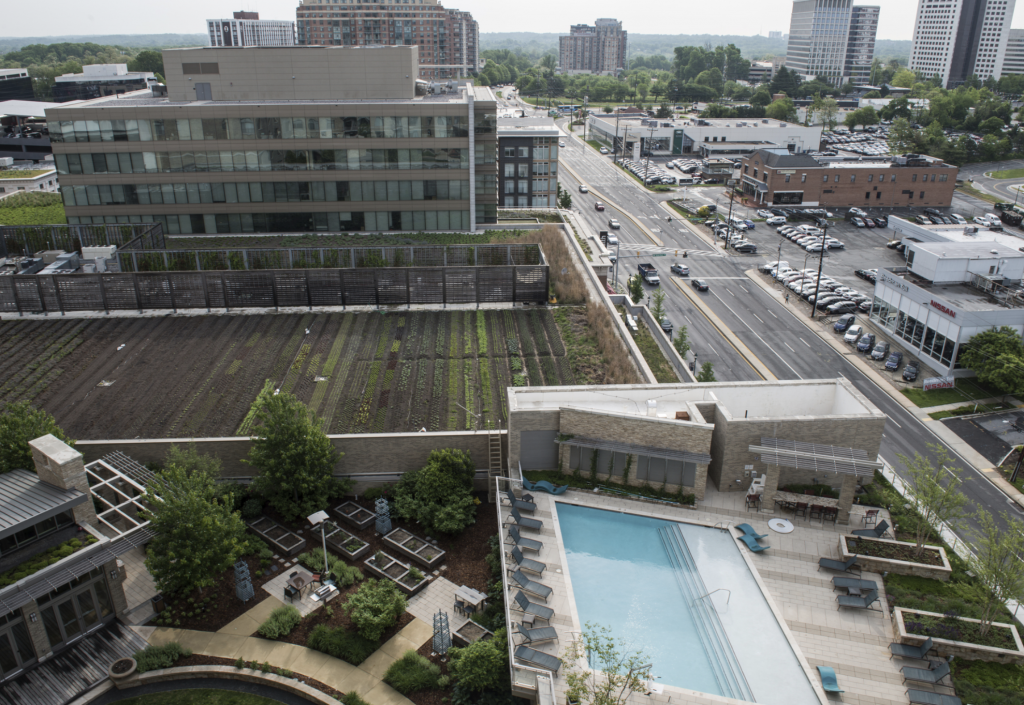
Since the building’s roof was already engineered to support the weight of eight inches of soil and any precipitation that might fall on it as a green roof, it was not too difficult to replace the existing ground cover with productive crops. Experience taught Up Top Acres that access and storage were key concerns. Working with FRIT they identified an unused portion of the adjacent parking garage — accessible both by truck from the outside and by elevator from the farm — which was fenced off to house farm supplies and a refrigeration unit. On the roof, a secondary storage area holds tools for the day-to-day management of the farm. The original roof access hatch located within the projection room of the iPic movie theater was not a realistic pathway for daily garden visits, so a ladder from the adjacent sixth-floor landing of the Pallas apartment building and a hoist for heavy lifting were constructed to facilitate transporting supplies and the ongoing harvest.
This summer, farmers harvested a rainbow of goodness from the rooftop: lettuce, cucumbers, watermelons, berries, swiss chard, okra, peppers (Shishito, Lunchbox and Carmen varieties), microgreens, herbs (basil, parsley, thyme, rosemary, sage, mint), lavender blossoms and edible flowers. All of the produce goes to customers within a few blocks of where it is grown. Remaining food and any farm shares that are not picked up are donated to the Manna Food Bank which serves the surrounding community.
Numerous Benefits
Operating a farm on the roof has distinct advantages from a wildlife perspective—it eliminates much of the danger from rodents as well as digging and foraging animals that are the bane of many ground-level farms — and it increases biodiversity within the city. The exposed area does attract birds, so fabric row covers are used to protect the most vulnerable and attractive crops. To ensure effective pollination, the farm features two beehives on site.
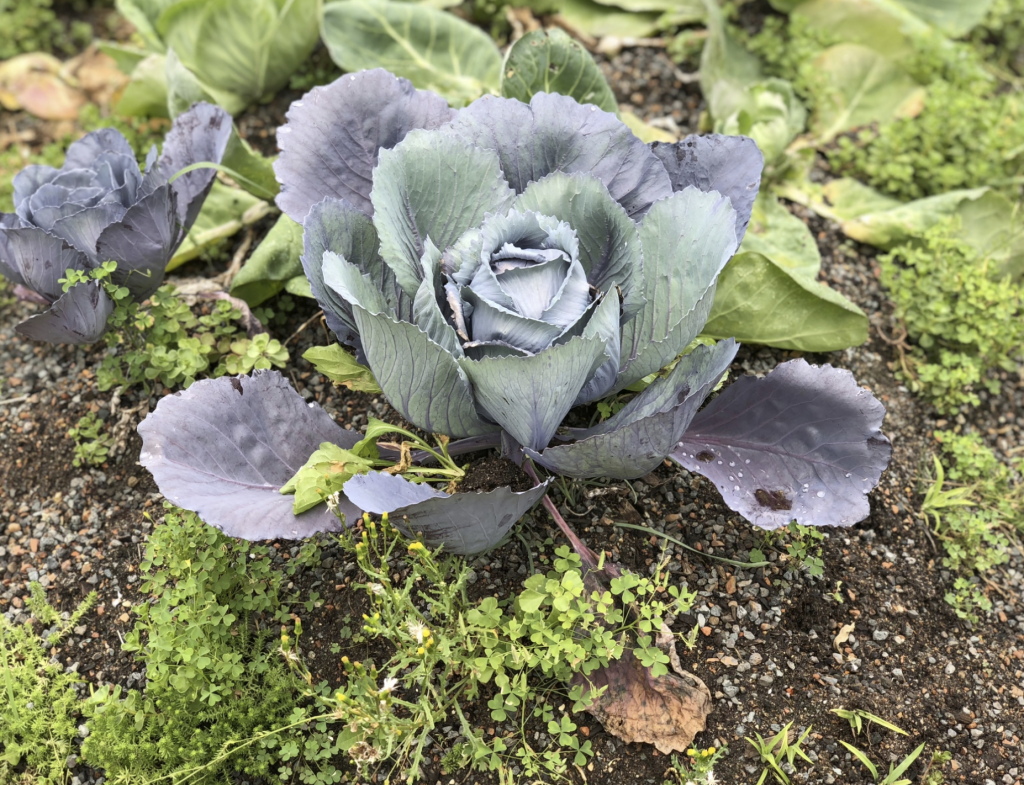
An unexpected benefit has been the positive response from tenants in adjacent buildings who enjoy watching the steady growth of the crops and the deliberate care of the farmers at work. Operation disruptions have been prevented by the careful design for getting farmers and equipment up and harvested produce down to the garage staging area. Other positives include the reduced cost of not having to maintain the section of the roof being farmed, and a mutually beneficial arrangement for enlisting the farmers for maintenance on the rest of the building’s green roof — providing some side income for the farmers and reducing the hassle and traffic of working with another contractor.
To minimize risks, the developer checked with the roof manufacturer to make sure the new usage would not void any product warranties and included liability protection in its agreement with Up Top Acres. Since weather is unpredictable, a smart sprinkler system was installed to monitor rainfall and adjust irrigation in response to need. A separate meter was installed for the sprinklers to ensure that the building’s water costs are equitably divided. With input and support from the University of Maryland Extension service, the Pike & Rose rooftop garden has become a pilot program for sustainable urban agriculture and the lessons and best practices discovered by the farmers are being collected and transmitted to other groups who are interested in similar projects.
For the farmers who started Up Top Acres — three of whom are Washington, D.C. natives — the Pike & Rose rooftop garden is the crowning jewel in the network of farms they’ve established to bring local food and sustainability to the urban landscape where they grew up. For the rest of us, the transformation of this ocean of impermeable concrete into a living, thriving ecosystem in the middle of a bustling mixed-use development is a window into the possibilities for coupling the convenience of city life with the ecological stewardship and wholesome freshness of local, sustainable farming.
About the Author: Mickey Papillon, CRRP, CSM, is Vice President – Regional General Manager, Federal Realty Investment Trust. Federal Realty’s environmental practices are reflected in the way they develop and manage their properties: from their efforts to minimize and reduce environmental impact through energy management, waste reduction and resource-efficient buildings in transit-oriented locations, to investing in renewable energy sources, and creating places that promote health and well-being.
Green Roof Benefits in Rain or Shine
In the open country, large swaths of green — lawn, forests, and farms — convert the sun’s light to energy for plant growth and cool the area around them. In the city, where asphalt, concrete, and rooftops absorb the heat during the day and release it at night, an “urban heat island” effect that raises the temperature of the entire area can be created. These impermeable surfaces send storm water into gutters and streets, carrying pollutants and biological contaminants into waterways.
Cities often focus on the vital work of reforestation and setting aside conservation areas and parks to mitigate some of these problems. But there are many ideas for incorporating permeable surfaces and growing spaces into the built environment that can magnify the benefits of these programs. Research by scientists at the University of Cardiff in the UK found that implementing green roofs and walls can significantly lower temperatures—the hotter the city, the greater the cooling effect. During the hottest months in Riyadh, Saudi Arabia, for example, a network of green roofs would shave 9.1 Celsius or about 16 degrees Fahrenheit from the temperature. The US Environmental Protection Agency estimates that a green roof also absorbs between 50-90 percent of the water and contaminants that would otherwise flow into storm drains.
Many states are embracing green construction codes that outline targets for reducing water and energy consumption, diverting debris from landfills, and mitigating heat island effects. For example, in Maryland, any development that affects more than 5,000 square feet of land triggers the state’s storm water performance standards that require developers to retain and treat 90 percent of the average annual rainfall. These policies, coupled with incentive programs that offer substantial rewards and tax credits for approved storm water management systems, have catapulted a number of area cities into the top 10 for number of green roof square feet, with Washington, DC coming in first. Green roofs also contribute to cleaner air quality and provide a building with natural insulation, decreasing heating and cooling costs.

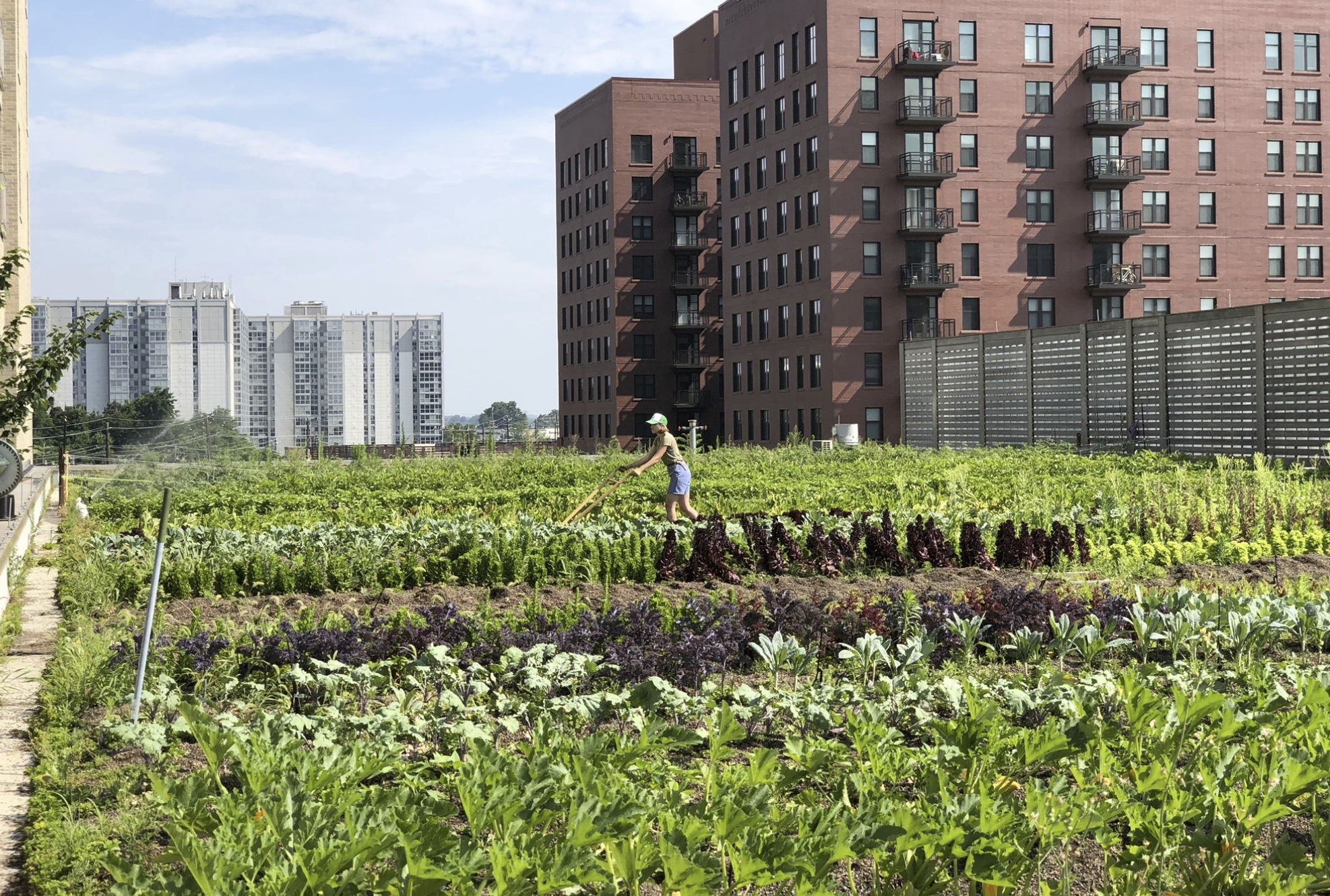


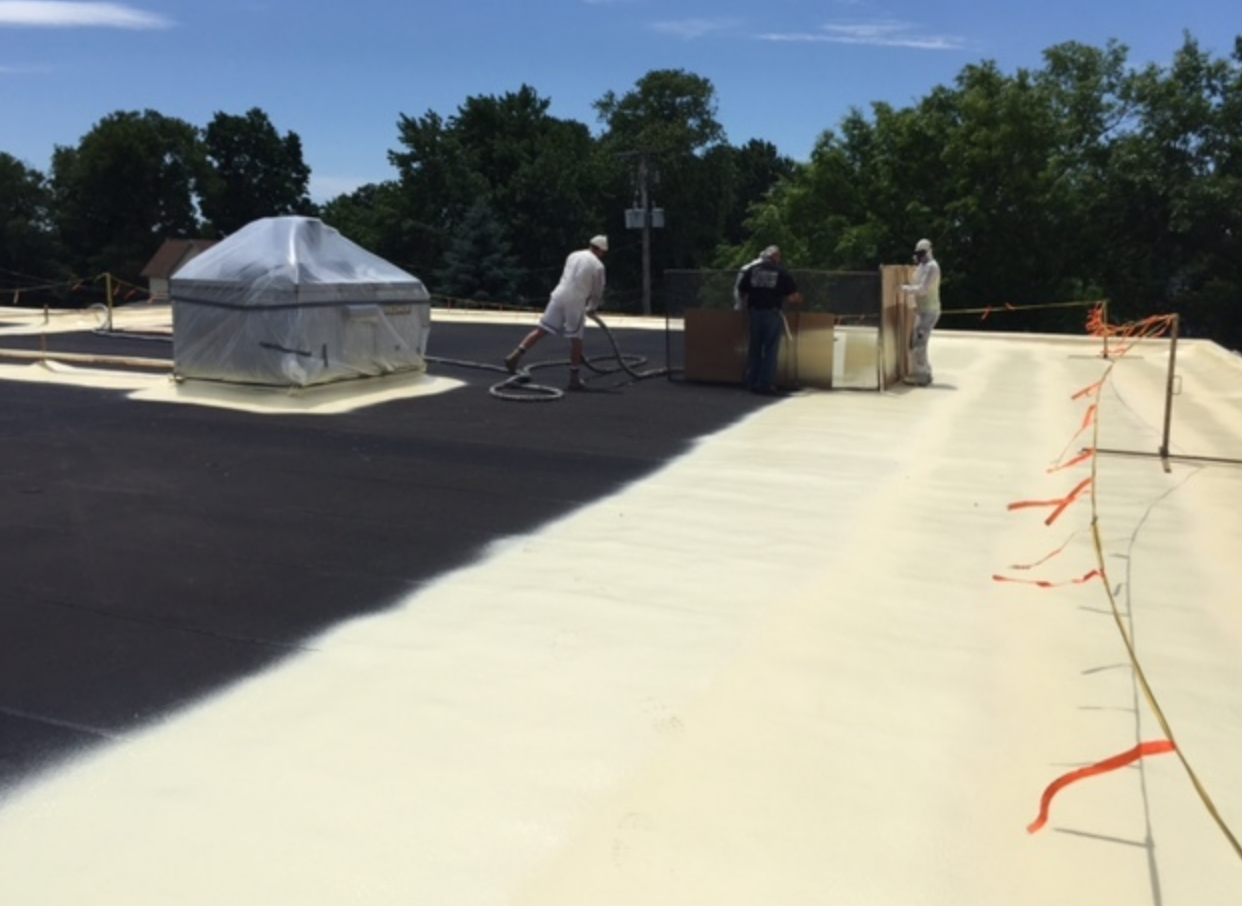
Be the first to comment on "At North Bethesda’s Pike & Rose, the Farm Is on Top of the Building"